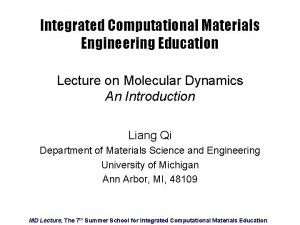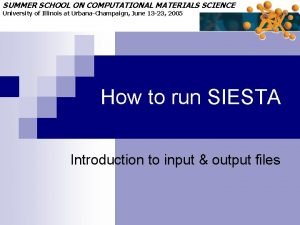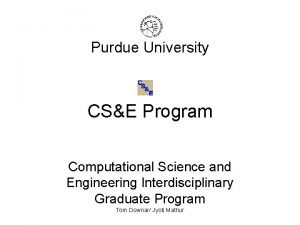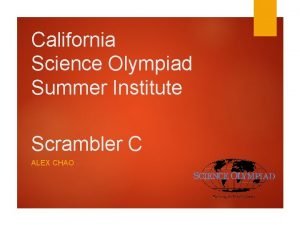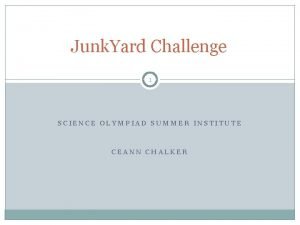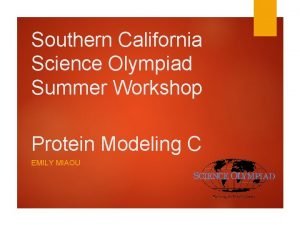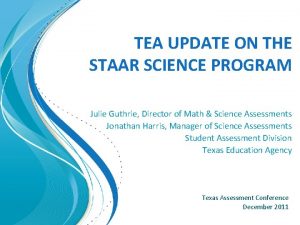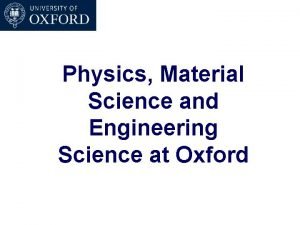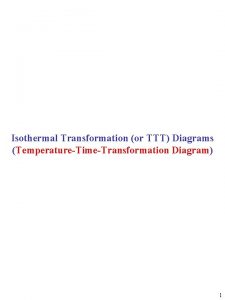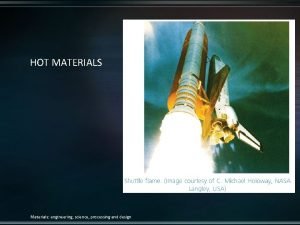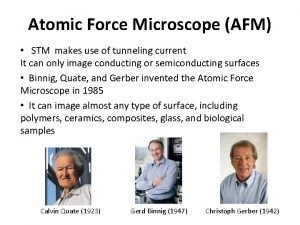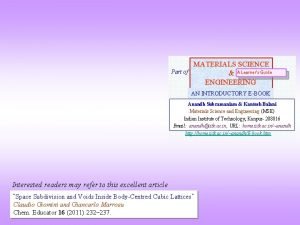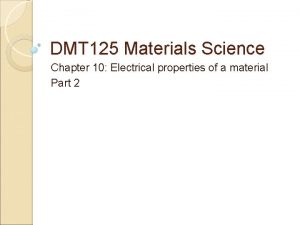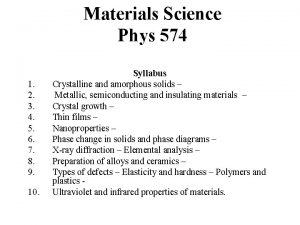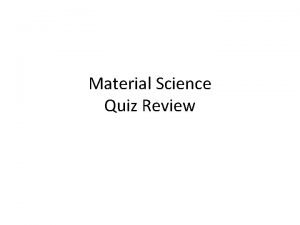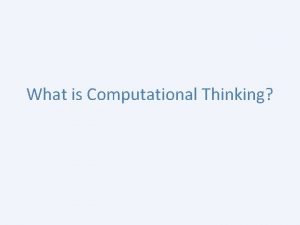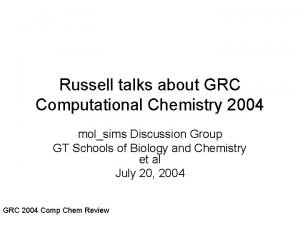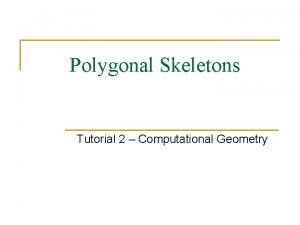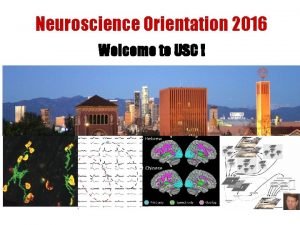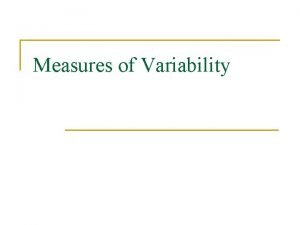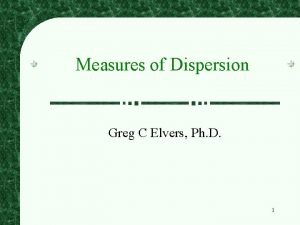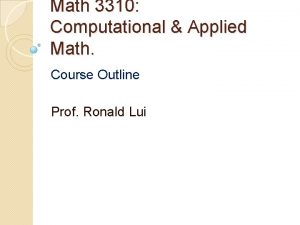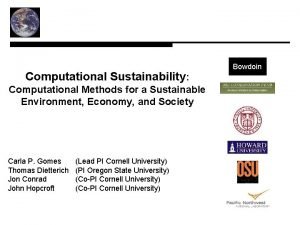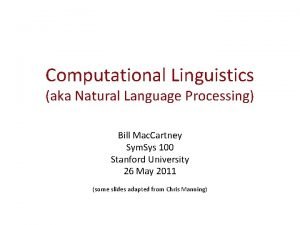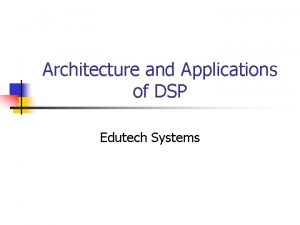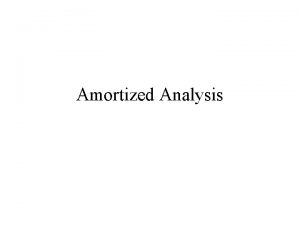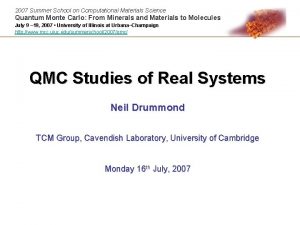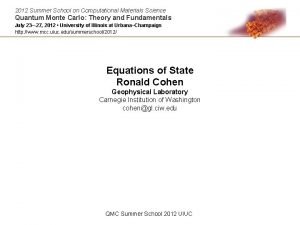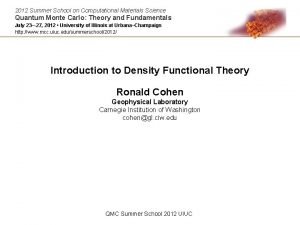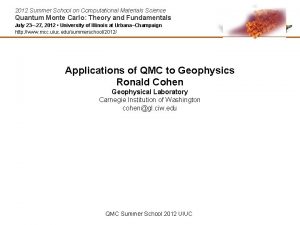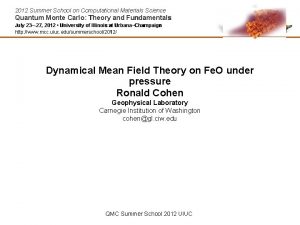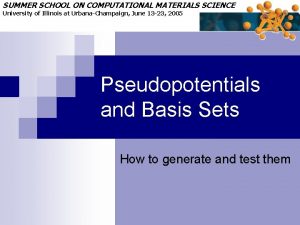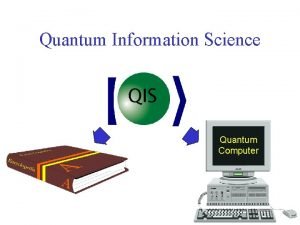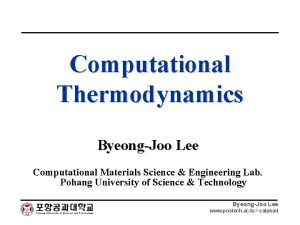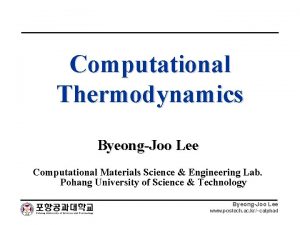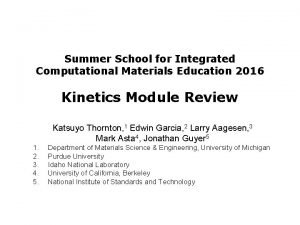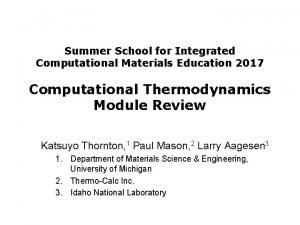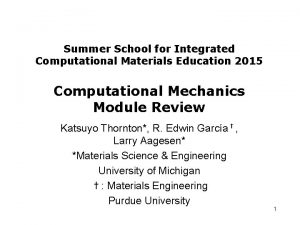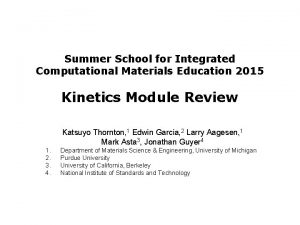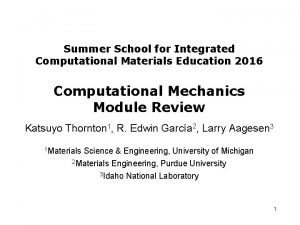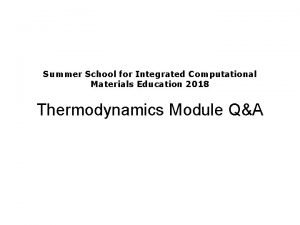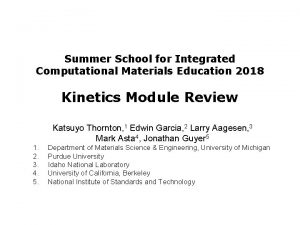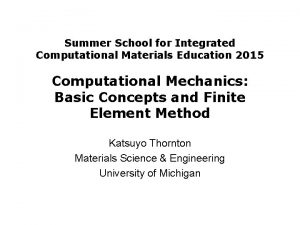2007 Summer School on Computational Materials Science Quantum


















































- Slides: 50

2007 Summer School on Computational Materials Science Quantum Monte Carlo: From Minerals and Materials to Molecules July 9 – 19, 2007 • University of Illinois at Urbana–Champaign http: //www. mcc. uiuc. edu/summerschool/2007/qmc/ New pairing wave functions and methods for non local pseudopotentials Michele Casula University of Illinois

Outline • Pairing wave functions for realistic systems – The concept of the resonating valence bond (RVB) – Geminal wave functions – Jastrow correlated geminal wave function as RVB ansatz • Diffusion Monte Carlo (DMC) methods with pseudopotentials – Non local pseudopotentials – Locality approximation – Effective fixed node Hamiltonians • Variational theorem • Non local Diffusion Monte Carlo • Lattice regularized Diffusion Monte Carlo • Application to some realistic systems – Iron dimer – Benzene dimer 2007 Summer School on Computational Materials Science 07 -16 -2007 New pairing wfs and methods for non local pseudopotentials (Casula) 2

Resonating valence bond (RVB) In this theory the chemical valence bond is described as a singlet pair of electrons spin up and spin down electrons in a singlet state a and b are nuclear indexes The true quantum state of a compound is a superposition or resonance of many valence bond states. The superposition usually improves the variational energy of the state. L. Pauling, Phys. Rev. 54, 899 (1938) Linus Pauling 2007 Summer School on Computational Materials Science 07 -16 -2007 New pairing wfs and methods for non local pseudopotentials (Casula) 3

Example of RVB 6 valence electrons in 6 sites (2 pz type) two ways to arrange nearest neighbor bonds (Kekule’ states) 2007 Summer School on Computational Materials Science 07 -16 -2007 New pairing wfs and methods for non local pseudopotentials (Casula) 4

RVB as projected BCS 1973: Anderson formulation of RVB theory on the triangular 2 D Heisenberg antiferromagnet S=1/2 with spin frustration P. W. Anderson, Mat. Res. Bull 8, 153 (1973) The number of bonds grows exponentially with the number of sites, but Anderson found a compact way to represent the RVB wave function. P. W. Anderson Gutzwiller projector forbids double occupancies on the same site BCS wave function: singlet pairing between electrons 1987: Anderson theory of High temperature superconductivity P. W. Anderson, Science 235, 1196 (1987) 2007 Summer School on Computational Materials Science 07 -16 -2007 New pairing wfs and methods for non local pseudopotentials (Casula) 5

Real space representation of RVB We fixed N, the number of particles (canonical ensemble): N/2 singlet pairs (valence bonds) Fourier transform of is the pairing function Pairs do not overlap for the action of the Gutzwiller projector The RVB wave function includes all possible combinations of valence bond configurations Snapshot (a single configuration) of the RVB state on a 2 D triangular lattice 2007 Summer School on Computational Materials Science 07 -16 -2007 New pairing wfs and methods for non local pseudopotentials (Casula) 6

Implementation of the RVB concept Generalization of the pairing function: non homogeneous symmetric pairing In the quantum chemistry community the pairing function is called geminal function, and the particle conserving version of the BCS wave function is called antisymmetrized geminal product (or AGP) Generalization of the Gutzwiller projector: not only on-site projection, but include also charge-charge (or spin -spin) correlations via a Jastrow factor J Monte Carlo implementation of the Jastrow correlated AGP wave function for realistic systems 2007 Summer School on Computational Materials Science 07 -16 -2007 New pairing wfs and methods for non local pseudopotentials (Casula) 7

AGP ansatz The value of the AGP function on the electron configuration is the determinant of the symmetric N/2 x N/2 matrix Single particle basis set expansion for the pairing function symmetric matrix gaussian basis set 2007 Summer School on Computational Materials Science 07 -16 -2007 New pairing wfs and methods for non local pseudopotentials (Casula) 8

Basis set dependence The basis set expansion of will determine the rank (number of non zero eigenvalues) of the matrix Minimal basis set: number of orbitals = N/2 rank of A = N/2 AGP = HF (best wave function written as a single Slater determinant) Expansion of the pairing beyond the minimal basis set: a single AGP determinant can be formally written as a linear combination of many Slater determinants (resonance) correlation is introduced with the computational cost of a single determinant 2007 Summer School on Computational Materials Science 07 -16 -2007 New pairing wfs and methods for non local pseudopotentials (Casula) 9

Berillium atom and near degeneracy 4 Slater determinants are needed to describe correctly its GS (the number of nodal pockets changes when 2 s 2 p resonance is included) The AGP wave function should be expanded to include both 2 s and 2 p Only one determinant instead of 4! 2007 Summer School on Computational Materials Science 07 -16 -2007 New pairing wfs and methods for non local pseudopotentials (Casula) 10

Jastrow correlated AGP wave function By means of QMC, the Jastrow correlated AGP (JAGP) wave function can be sampled just like a Jastrow-Slater determinant. The Jastrow factor reads: Also the Jastrow factor is expanded using a pairing function. I n this case the antisymmetrization is not needed, being the Jastrow a bosonic component of the wave function. two-body term to cure electron-electron cusp conditions Jastrow pairing includes one-body, three-body, and four-body contributions 2007 Summer School on Computational Materials Science 07 -16 -2007 New pairing wfs and methods for non local pseudopotentials (Casula) 11

Energetics of the Be atom ground state Casula, Sorella JCP 119, 6500 (2003) AGP with larger basis worse than JAGP 2007 Summer School on Computational Materials Science 07 -16 -2007 New pairing wfs and methods for non local pseudopotentials (Casula) 12

Benzene with JAGP Kekule’ diagrams Terms in the RVB wave function AE calculations Dewar diagrams VMC cohesive energy (%) DMC FN cohesive energy (%) Kekule + 3 body 83. 05(7) 93. 75(17) Resonating Kekule + 3 body 86. 65(7) 96. 64(15) Resonating Dewar Kekule + 3 body 88. 67(7) 98. 60(13) Resonating Dewar Kekule + 2 body 58. 66(8) 95. 95(18) Casula, Attaccalite, Sorella JCP 121, 7110 (2004) Jastrow+AGP changes the nodes! 2007 Summer School on Computational Materials Science 07 -16 -2007 New pairing wfs and methods for non local pseudopotentials (Casula) 13

Interplay Jastrow-AGP The AGP wave function has less variational freedom than the Configuration Interaction (full expansion in the Slater determinant space) but cures near degeneracy effects Effect of the Jastrow factor: • Cusp conditions fulfilled! • Faster convergence of the AGP expansion • Dynamical correlations (charge fluctuations) • Local conservation of the charge in a molecule 2007 Summer School on Computational Materials Science 07 -16 -2007 New pairing wfs and methods for non local pseudopotentials (Casula) 14

Spin polarized AGP Suppose we have a spin unbalance with then the AGP wave function reads A is a where matrix: are the unpaired orbitals. Notice that for a fully polarized system the AGP reduces to the HF because the AGP does not contain triplet pair correlations! Beyond AGP pairing: multi AGP, pfaffian, multi pfaffian See for instance, M. Bajdich, L. Mitas et al. Phys. Rev. Lett. 96, 130201 (2006) 2007 Summer School on Computational Materials Science 07 -16 -2007 New pairing wfs and methods for non local pseudopotentials (Casula) 15

Standard DMC stochastic method to find the ground state (GS) energy of H In case of fermions, boundary conditions given by the nodes of the guidance wave function (fixed node approximation) DMC algorithm with importance sampling 1. Sample initial walkers from 2. Move the walkers according to the Green’s function - Drift and diffuse (from the kinetic part of H) - Weight the potential must be local! 3. Branching step (birth-death process according to the weights) After thebranching reset the weights to 1. 4. After repeating many times 2. and 3. the walker population will sample the positive mixed distribution 2007 Summer School on Computational Materials Science 07 -16 -2007 New pairing wfs and methods for non local pseudopotentials (Casula) 16

Mixed estimates Diffusion Monte Carlo expectation values: As fixed node GS of H MIXED AVERAGE ESTIMATE “PURE” EXPECTATION VALUE computed by DMC Important consequence: from the variational theorem UPPER BOUND PROPERTY FOR LOCAL POTENTIALS 2007 Summer School on Computational Materials Science 07 -16 -2007 New pairing wfs and methods for non local pseudopotentials (Casula) 17

DMC drawbacks • bad scaling of DMC with the atomic number D. M. Ceperley, J. Stat. Phys. 43, 815(1986) A. Ma et al. , PRE 71, 066704(2005) • locality approximation needed in the presence of non local potentials (pseudopotentials) non variational results strong dependence on the guidance wave function simulations less stable when pseudo are included 2007 Summer School on Computational Materials Science 07 -16 -2007 New pairing wfs and methods for non local pseudopotentials (Casula) 18

Locality approximation in DMC Mitas et al. J. Chem. Phys. 95, 3467 (1991) Effective Hamiltonian HLA containing the localized potential: • the mixed estimate is not variational since • in general it will depend on the shape of (locality is exact only if is exact) 2007 Summer School on Computational Materials Science 07 -16 -2007 New pairing wfs and methods for non local pseudopotentials (Casula) 19

Pseudopotentials q For heavy atoms pseudopotentials are necessary to reduce the computational time q Usually they are non local In QMC angular momentum projection is calculated by using a quadrature rule for the integration S. Fahy, X. W. Wang and Steven G. Louie, PRB 42, 3503 (1990) Discretization of the projection 2007 Summer School on Computational Materials Science 07 -16 -2007 New pairing wfs and methods for non local pseudopotentials (Casula) 20

Non locality in DMC Hamiltonian with local and non local potentials Trotter breakup Importance sampling Green function Non local matrix T 2007 Summer School on Computational Materials Science 07 -16 -2007 New pairing wfs and methods for non local pseudopotentials (Casula) 21

Non local T matrix linear form from expansion up to order same matrix elements for non local V as computed in the locality approximation V(y, x) is not positive definite, we have to impose the FN approximation to interpret T(y, x) as a transition probability 2007 Summer School on Computational Materials Science 07 -16 -2007 New pairing wfs and methods for non local pseudopotentials (Casula) 22

Non local T with fixed node approximation In order to interpret the T matrix as a transition probability, we should normalized it, by integrating over all possible final positions, whose number is finite (heat bath move). The normalization factor is: IMPORTANT STEP: add the discarded V+ terms to the local potential Sign flip term in local V Upper bound property!!! 2007 Summer School on Computational Materials Science 07 -16 -2007 New pairing wfs and methods for non local pseudopotentials (Casula) 23

Sign flip and upper bound property True Hamiltonian Effective Hamiltonian Sign flip term: sum over all the positive V(y, x) discarded in the effective H Only positive terms are localized in The integration domain D is given by those pairs (x’, x) s. t. V(x’, x) > 0, taken only once. Straightforward extension of the proof given by D. F. B. ten Haaf et al. (PRB 51, 13039 (1995)) for lattice Hamiltonians. 2007 Summer School on Computational Materials Science 07 -16 -2007 New pairing wfs and methods for non local pseudopotentials (Casula) 24

Final scheme: non local DMC Three steps in the evolution of the walkers: the non local move is the new one introduced in the non local DMC scheme diffusion + drift (with rejection) non local move (heat bath) weight with local energy (it includes the contribution from both diffusion and non local move) 2007 Summer School on Computational Materials Science 07 -16 -2007 New pairing wfs and methods for non local pseudopotentials (Casula) 25

Stability Carbon pseudoatom (He core, SBK pseudo) 2007 Summer School on Computational Materials Science 07 -16 -2007 New pairing wfs and methods for non local pseudopotentials (Casula) 26

Stability nodal surface non local move q locality approximation large and negative attractive potential close to the nodal surface (it works for good trial functions / small time steps) q non local move jumps the divergence and crosses the node (the nasty negative contributions in the locality approximation are good non local matrix elements in the non local DMC scheme) 2007 Summer School on Computational Materials Science 07 -16 -2007 New pairing wfs and methods for non local pseudopotentials (Casula) 27

Non local DMC: summary • robust (stable even for “poor” wave functions or “hard” pseudopotentials) • upper bound of the energy (sign flip term included) • pure expectation value of the FN Hamiltonian (but an extra cost is required, and usually the mixed estimate error cancels out in the energy differences) • easy to implement (only one extra step in the propagation of the standard DMC algorithm) • time step error only slightly larger than standard DMC (due to the linearization of the T matrix) M. Casula, PRB 74, 161102(R) (2006) 2007 Summer School on Computational Materials Science 07 -16 -2007 New pairing wfs and methods for non local pseudopotentials (Casula) 28

From non local DMC to lattice regularized DMC (LRDMC) Lattice regularized DMC discretization of the laplacian + discretization of the non local potential Non local DMC discretization of the non local potential 2007 Summer School on Computational Materials Science 07 -16 -2007 New pairing wfs and methods for non local pseudopotentials (Casula) 29

Lattice regularization Kinetic term: discretization of the laplacian Laplacian with finite differences in the 1 D case: General d dimensional case: where are translation operators. hopping term t 1/a 2 where a is the discretization mesh 2007 Summer School on Computational Materials Science 07 -16 -2007 New pairing wfs and methods for non local pseudopotentials (Casula) 30

Projection�� Monte Carlo on a lattice Lattice Hamiltonian: Propagator: Importance sampling For large enough, G will project to the lowest energy state Projection implemented by the following Markov process: hopping given by the transition probability weight For fermions, fixed node approximation to have a well defined transition probability 2007 Summer School on Computational Materials Science 07 -16 -2007 New pairing wfs and methods for non local pseudopotentials (Casula) 31

Fixed node with sign flip contribution Green’s function Hop with sign change replaced by a positive diagonal potential UPPER BOUND THEOREM ! D. F. B. ten Haaf et al. PRB 51, 13039 (1995) 2007 Summer School on Computational Materials Science 07 -16 -2007 New pairing wfs and methods for non local pseudopotentials (Casula) 32

LRDMC with pseudo Two types of off diagonal matrix elements Discretized Laplacian translations Discretized non local pseudopotential rotations around a nucleus 2007 Summer School on Computational Materials Science 07 -16 -2007 New pairing wfs and methods for non local pseudopotentials (Casula) 33

DMC vs LRDMC extrapolation properties DMC LRDMC Trotter approximation For each a well defined Hamiltonian Time step extrapolation Lattice space a extrapolation dependence a 2 ( a 4 ) dependence same diffusion constant Efficiency (CPU time to have the same statistical error) 2007 Summer School on Computational Materials Science 07 -16 -2007 New pairing wfs and methods for non local pseudopotentials (Casula) 34

Error in the discretization Discretized non local pseudopotential discretization error reduced by the randomization of the quadrature mesh Discretized Laplacian discretization error reduced by the introduction of a double mesh 2007 Summer School on Computational Materials Science 07 -16 -2007 New pairing wfs and methods for non local pseudopotentials (Casula) 35

Lattice discretization with two meshes Double mesh for the discretized laplacian a finest mesh, b largest p is a function which sets the relative weight of the two meshes. It can depend on the distance from the nucleus: Our choice: Separation of core and valence dynamics for heavy nuclei by means of two hopping terms in the kinetic part Moreover, if b is not a multiple of a, the random walk can sample the space more densely! 2007 Summer School on Computational Materials Science 07 -16 -2007 New pairing wfs and methods for non local pseudopotentials (Casula) 36

Two hopping terms Example: 1 D system with 2 electrons (1 up, 1 down) and PBC 2007 Summer School on Computational Materials Science 07 -16 -2007 New pairing wfs and methods for non local pseudopotentials (Casula) 37

Lattice regularized Hamiltonian Definition of lattice regularized Hamiltonian Ø Continuous limit: for a 0, Ha H Ø Local energy of Ha = local energy of H Ø �rescaling factor of the discretized kinetic energy Faster convergence in the lattice space a! M. Casula, C. Filippi, S. Sorella, PRL 95, 100201 (2005) 2007 Summer School on Computational Materials Science 07 -16 -2007 New pairing wfs and methods for non local pseudopotentials (Casula) 38

Convergence for C S. Sorella, M. Casula, D. Rocca, J. Chem. Phys. 127, 014105 (2007) 2007 Summer School on Computational Materials Science 07 -16 -2007 New pairing wfs and methods for non local pseudopotentials (Casula) 39

Silicon 2007 Summer School on Computational Materials Science 07 -16 -2007 New pairing wfs and methods for non local pseudopotentials (Casula) 40

LRDMC: summary • same properties of the non local DMC in terms of stability and variational upper bound (also the LRDMC effective Hamiltonian includes the sign flip term) • more difficult to implement in the available codes (LRDMC is based more upon the lattice Green function Monte Carlo, than the standard Diffusion Monte Carlo) • double mesh in the laplacian can help to decorrelate faster the electrons (core-valence separation) • freedom in the kinetic part of the effective Hamiltonian allows to reduce a lot the lattice space error, and improve the efficiency (by “fitting” the lattice space dependence for the heaviest element in the compound) See also http: //www. sissa. it/cm/thesis/2005/casula. pdf 2007 Summer School on Computational Materials Science 07 -16 -2007 New pairing wfs and methods for non local pseudopotentials (Casula) 41

Iron dimer PHOTOELECTRON SPECTROSCOPY GS anion: GS neutral: Leopold and Lineberger, J. Chem. Phys. 85, 51(1986) previous NUMERICAL STUDIES on the neutral iron dimer q DFT methods: q more correlated methods (CC, MRCI, DFT+U): q electron affinity very hard to compute 2007 Summer School on Computational Materials Science 07 -16 -2007 New pairing wfs and methods for non local pseudopotentials (Casula) 42

Calculation details Dolg pseudopotentials neon core spd non local components scalar relativistic corrections included Gaussian basis set for JAGP wave function (8 s 5 p 6 d)/[2 s 1 p 1 d] contracted for AGP Total independent parameters: 227 2007 Summer School on Computational Materials Science 07 -16 -2007 New pairing wfs and methods for non local pseudopotentials (Casula) 43

Dispersion curves 2007 Summer School on Computational Materials Science 07 -16 -2007 New pairing wfs and methods for non local pseudopotentials (Casula) 44

Neutral ground state LRDMC gives for neutral dimer 2007 Summer School on Computational Materials Science 07 -16 -2007 New pairing wfs and methods for non local pseudopotentials (Casula) 45

Neutral ground state The lack of correlation leads to underestimate the “on-site” repulsion in the d orbitals, and overestimate the 4 splitting. LRDMC DFT-PP 86 Physical Review B, 66 (2002) 155425 2007 Summer School on Computational Materials Science 07 -16 -2007 New pairing wfs and methods for non local pseudopotentials (Casula) 46

Iron dimer: structural properties LRDMC Harmonicequilibrium frequency: distance: 301 (15) 3. 818(11) cm-1 Experimentalvalue: ~~4. 093(19) 300 (15) cm-1 2007 Summer School on Computational Materials Science 07 -16 -2007 New pairing wfs and methods for non local pseudopotentials (Casula) 47

Iron dimer: photoelectron spectrum Experiment Incoming photon: 2. 540 e. V Temperature 300 K LRDMC 2007 Summer School on Computational Materials Science 07 -16 -2007 New pairing wfs and methods for non local pseudopotentials (Casula) 48

Benzene dimer Van der Waals + ����interactions Important for DNA and protein structures Binding energy (kcal/mol) 0. 5(3) parallel 2. 2(3) slipped parallel 0. 37 ZPE 1. 6(2) experiment S. Sorella, M. Casula, D. Rocca, J. Chem. Phys. 127, 014105 (2007) 2007 Summer School on Computational Materials Science 07 -16 -2007 New pairing wfs and methods for non local pseudopotentials (Casula) 49

Conclusion and perspectives about the DMC method • The pseudopotentials can be “safely” included in the DMC, with the possibility to perform accurate simulations for large or extended systems, in solid state physics or quantum chemistry. • The fixed node approximation is still the major problem for this zero temperature technique. • The flexibility in the new correlated trial wave functions (like geminals, pfaffians, backflow transformations) can partially alleviate the fixed node error, which is very small for very good trial wave functions. • However we need efficient optimization methods to optimize complex wave functions with many parameters and within a stochastic framework (see C. Umrigar’s lecture on the variational optimization) 2007 Summer School on Computational Materials Science 07 -16 -2007 New pairing wfs and methods for non local pseudopotentials (Casula) 50
 Tu bergakademie freiberg computational materials science
Tu bergakademie freiberg computational materials science Integrated computational materials engineering
Integrated computational materials engineering Integrated computational materials engineering
Integrated computational materials engineering Quantum physics vs mechanics
Quantum physics vs mechanics Quantum physics vs quantum mechanics
Quantum physics vs quantum mechanics Ece 570 purdue
Ece 570 purdue Lodi unified summer school
Lodi unified summer school Crescenta valley high school graduation 2021
Crescenta valley high school graduation 2021 Assignment in spanish
Assignment in spanish It is my favourite subject
It is my favourite subject Go noodle cant stop the feeling
Go noodle cant stop the feeling Difference between useful and harmful materials
Difference between useful and harmful materials Man made map
Man made map Adopting and adapting teaching materials
Adopting and adapting teaching materials Direct materials budget with multiple materials
Direct materials budget with multiple materials High school 2008 fashion
High school 2008 fashion Science olympiad scrambler
Science olympiad scrambler Summer science program
Summer science program Vanderbilt summer science academy
Vanderbilt summer science academy Science olympiad summer institute
Science olympiad summer institute Science olympiad southern california
Science olympiad southern california Staar passing score 2021
Staar passing score 2021 Material science oxford
Material science oxford Natural sciences and technology
Natural sciences and technology Natural science grade 7 term 3
Natural science grade 7 term 3 Introduction to materials science for engineers chapter 10
Introduction to materials science for engineers chapter 10 Materials engineering science processing and design
Materials engineering science processing and design Materials science
Materials science Octahedral voids in bcc
Octahedral voids in bcc Introduction to materials science for engineers chapter 10
Introduction to materials science for engineers chapter 10 Dmse iit delhi
Dmse iit delhi Solutions grade 6
Solutions grade 6 Materials science
Materials science Materials science quiz
Materials science quiz Ashby plots
Ashby plots Characteristics of computational thinking
Characteristics of computational thinking Computational thinking algorithms and programming
Computational thinking algorithms and programming Grc computational chemistry
Grc computational chemistry Using mathematics and computational thinking
Using mathematics and computational thinking Straight skeleton
Straight skeleton Usc neuroscience minor
Usc neuroscience minor Standard deviation computational formula
Standard deviation computational formula What is dispersion in statistics
What is dispersion in statistics Computational math
Computational math Abstraction computer science gcse
Abstraction computer science gcse Computational sustainability scope
Computational sustainability scope Chomsky computational linguistics
Chomsky computational linguistics Xkcd computational linguistics
Xkcd computational linguistics Comp bio cmu
Comp bio cmu C6748 architecture supports
C6748 architecture supports Amortized computational complexity
Amortized computational complexity

